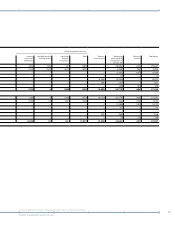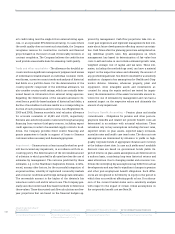Siemens 2009 Annual Report Download - page 223
Download and view the complete annual report
Please find page 223 of the 2009 Siemens annual report below. You can navigate through the pages in the report by either clicking on the pages listed below, or by using the keyword search tool below to find specific information within the annual report.
Managing Board statements, Independent auditors’ report, Additional information
Notes to Consolidated Financial Statements
(in millions of €, except where otherwise
stated and per share amounts)
asset is impaired, the cumulative loss that has been recog-
nized in equity is removed from equity and recognized in the
Consolidated Statements of Income. The Company considers
all available evidence such as market conditions and prices,
investee-specific factors and the duration and the extent to
which fair value is less than acquisition cost in evaluating po-
tential impairment of its available-for-sale financial assets. The
Company considers a decline in fair value as objective evi-
dence of impairment, if the decline exceeds 20 percent of
costs or continues for more than six months. An impairment
loss is reversed in subsequent periods for debt instruments, if
the reasons for the impairment no longer exist.
Loans and receivables – Financial assets classified as loans
and receivables are measured at amortized cost using the ef-
fective interest method less any impairment losses. Impair-
ment losses on trade and other receivables are recognized us-
ing separate allowance accounts. See Note 3 for further infor-
mation regarding the determination of impairment. Loans and
receivables bearing no or lower interest rates compared to
market rates with a maturity of more than one year are being
discounted.
Financial liabilities – Siemens measures financial liabilities,
except for derivative financial instruments, at amortized cost
using the effective interest method.
Derivative financial instruments – Derivative financial in-
struments, such as foreign currency exchange contracts and
interest rate swap contracts, are measured at fair value. Deriv-
ative instruments are classified as held for trading unless they
are designated as hedging instruments, for which hedge ac-
counting is applied. Changes in the fair value of derivative fi-
nancial instruments are recognized periodically either in net
income or, in the case of a cash flow hedge, in Other compo-
nents of equity, net of applicable deferred income taxes. Cer-
tain derivative instruments embedded in host contracts are
also accounted for separately as derivatives.
Fair value hedges – The carrying amount of the hedged item
is adjusted by the gain or loss attributable to the hedged risk.
Where an unrecognized firm commitment is designated as the
nancial instruments are classified as financial assets and finan-
cial liabilities measured at cost or amortized cost and financial
assets and financial liabilities measured at fair value and as re-
ceivables from finance leases. See Notes 31 and 32 for further
information.
Financial instruments are recognized on the balance sheet
when Siemens becomes a party to the contractual obligations
of the instrument. For regular way purchases or sales of finan-
cial assets, i.e. purchases or sales under a contract whose
terms require delivery of the asset within the time frame es-
tablished generally by regulation or convention in the market-
place concerned, the trade date is applied.
Initially, financial instruments are recognized at their fair
value. Transaction costs directly attributable to the acquisition
or issue of financial instruments are only recognized in deter-
mining the carrying amount, if the financial instruments are
not measured at fair value through profit or loss. Finance lease
receivables are recognized at an amount equal to the net in-
vestment in the lease. Subsequently, financial assets and lia-
bilities are measured according to the category – cash and
cash equivalents, available-for-sale financial assets, loans and
receivables, financial liabilities measured at amortized cost or
financial assets and liabilities classified as held for trading – to
which they are assigned.
Cash and cash equivalents – The Company considers all
highly liquid investments with less than three months matu-
rity from the date of acquisition to be cash equivalents. Cash
and cash equivalents are measured at cost.
Available-for-sale financial assets – Investments in equity in-
struments, debt instruments and fund shares are all classified
as available-for-sale financial assets. They are accounted for at
fair value if reliably measurable, with unrealized gains and
losses included in Other components of equity, net of applica-
ble deferred income taxes. Equity instruments that do not
have a quoted market price in an active market and whose fair
value cannot be reliably measured are recorded at cost. When
available-for-sale financial assets incur a decline in fair value
below acquisition cost and there is objective evidence that the
























